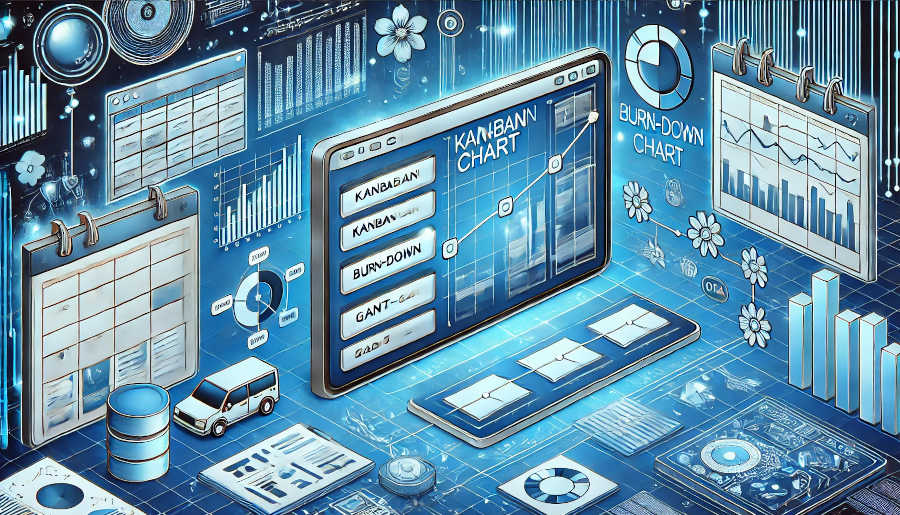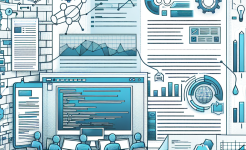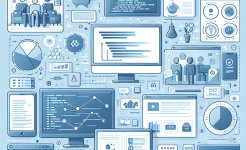In the realm of project management, especially for agile projects, choosing the right visual tool to track progress is crucial. Two popular options are the Burndown chart and the Gantt chart. These charts serve as essential aids for project managers, teams, and stakeholders to understand the project's status, anticipate completion, and identify potential issues. While both have their merits, understanding their differences and when to use each can significantly impact the success of an agile project.
The Burndown chart is a simple yet powerful visual representation that shows the remaining work over time. It provides a clear picture of whether the project is on track to meet its goals. On the other hand, the Gantt chart is a more traditional tool that displays tasks, their start and end dates, and dependencies. It offers a comprehensive view of the project schedule. By exploring their features, advantages, and limitations, project teams can make an informed decision on which chart best suits their agile project needs.
Understanding the Burndown Chart
The Burndown chart is a staple in agile project management. It focuses on the amount of work remaining in a project or sprint. The vertical axis represents the amount of work, which can be measured in various units such as story points, hours, or tasks. The horizontal axis shows the time, typically in days or sprints. As the project progresses, the line on the chart should slope downwards, indicating that the work is being completed.
One of the key benefits of the Burndown chart is its simplicity. It provides a quick and easy way for the team and stakeholders to see how the project is progressing. It also helps in identifying if the team is falling behind or ahead of schedule. If the line on the chart is not sloping down as expected, it signals that there may be issues such as underestimated work, unforeseen obstacles, or a lack of resources.
Moreover, the Burndown chart promotes transparency within the team. Everyone can clearly see the progress of the project and understand their role in achieving the goals. It encourages open communication and collaboration as team members can discuss any deviations from the expected progress and work together to address them. This transparency also helps in managing stakeholder expectations as they can easily visualize the project's progress over time.
Exploring the Gantt Chart
The Gantt chart has been a widely used project management tool for decades. It presents a detailed schedule of tasks, showing their start and end dates, as well as any dependencies between them. Each task is represented as a bar on the chart, and the length of the bar corresponds to the duration of the task. The Gantt chart can be used to plan, schedule, and track projects of all sizes and complexities.
One of the main advantages of the Gantt chart is its ability to display the project timeline in a visual and organized manner. It allows project managers to easily identify the critical path of the project, which is the sequence of tasks that determines the overall project duration. By focusing on the critical path, managers can allocate resources effectively and ensure that the project stays on track.
In addition, the Gantt chart is useful for communicating the project schedule to stakeholders. It provides a clear overview of when each task will start and end, allowing stakeholders to plan their own activities accordingly. The chart can also be used to show the impact of changes to the schedule, such as delays or rescheduling of tasks. This helps in making informed decisions and managing risks.
Comparing the Two Charts in Agile Projects
When it comes to agile projects, the choice between the Burndown chart and the Gantt chart depends on several factors. The Burndown chart is more aligned with the agile principles of simplicity, transparency, and adaptability. It is ideal for tracking the progress of work within a sprint or iteration, as it focuses on the remaining work rather than the detailed schedule of tasks.
The Gantt chart, on the other hand, is better suited for projects that require a more detailed and structured approach to planning and scheduling. It can be useful in the initial stages of an agile project to define the overall project timeline and dependencies. However, in the later stages of an agile project, when the focus is on continuous delivery and adaptation, the Gantt chart may become less relevant as it can be more difficult to update and maintain.
Another aspect to consider is the level of detail required. The Burndown chart provides a high-level view of the project progress, which is sufficient for most agile teams. It allows for quick identification of trends and issues without getting bogged down in too much detail. The Gantt chart, on the other hand, can provide a very detailed view of the project schedule, which may be necessary for complex projects with many dependencies.
Advantages of the Burndown Chart in Agile
The Burndown chart offers several advantages specifically for agile projects. Firstly, it promotes a sense of urgency within the team. As the line on the chart shows the remaining work, team members are constantly aware of the need to complete tasks in a timely manner. This helps in maintaining a high level of productivity and focus.
Secondly, the Burndown chart is highly adaptable to changes in the project scope. In agile projects, requirements often change during the course of the project. The Burndown chart can easily accommodate these changes by simply adjusting the amount of work remaining. This flexibility allows the team to respond quickly to new requirements and keep the project on track.
Finally, the Burndown chart is a great tool for continuous improvement. By analyzing the data from previous sprints, the team can identify patterns and trends in their work. This can help in making more accurate estimates in future sprints, improving the team's efficiency, and ultimately delivering better results.
Advantages of the Gantt Chart in Agile
While the Gantt chart may not be as commonly used in pure agile projects, it still has some advantages. One of the main benefits is its ability to show the overall project timeline and dependencies. This can be useful in the early stages of an agile project when the team is trying to understand the big picture and plan the initial sprints.

The Gantt chart can also be helpful in coordinating with external stakeholders who may be more familiar with traditional project management tools. By presenting the project schedule in a Gantt chart format, it becomes easier to communicate with these stakeholders and ensure that everyone is on the same page.
In addition, the Gantt chart can be used to manage resources more effectively. By showing the start and end dates of each task, project managers can allocate resources based on the workload and availability. This helps in avoiding overloading team members and ensuring that the project is completed within the allocated time and budget.
Limitations of the Burndown Chart
Despite its many advantages, the Burndown chart also has some limitations. One of the main drawbacks is that it does not provide detailed information about individual tasks. It only shows the total amount of work remaining, which may not be sufficient for teams that need to track the progress of specific tasks.
Another limitation is that the Burndown chart assumes a linear progress of work. In reality, the progress of a project may not be as smooth as the chart implies. There may be periods of high productivity followed by slower periods, or unexpected issues may arise that cause delays. The Burndown chart may not accurately reflect these fluctuations in progress.
Finally, the Burndown chart may not be suitable for projects with complex dependencies between tasks. Since it focuses on the overall work remaining, it may not be able to show how changes in one task can impact the progress of other tasks.
Limitations of the Gantt Chart
The Gantt chart also has its limitations, especially in the context of agile projects. One of the main issues is that it can be time-consuming to create and update. As the project progresses and changes occur, the Gantt chart needs to be adjusted accordingly, which can be a complex and laborious process.
Another limitation is that the Gantt chart can be too rigid for agile projects. Agile projects are characterized by their flexibility and adaptability, and the Gantt chart may not be able to accommodate the frequent changes in requirements and priorities. It may also create a false sense of certainty about the project schedule, as it assumes that tasks will be completed as planned without any disruptions.
Finally, the Gantt chart may not be as effective in promoting collaboration and communication within the team. Since it focuses on the schedule and tasks, it may not encourage the same level of open discussion and transparency as the Burndown chart.
Choosing the Right Chart for Your Agile Project
When deciding between the Burndown chart and the Gantt chart for an agile project, it is important to consider the specific needs and characteristics of the project. If the project requires a high level of flexibility, adaptability, and transparency, and the focus is on the progress of work within sprints, the Burndown chart may be the better choice.
On the other hand, if the project has complex dependencies, requires a detailed schedule, or needs to communicate with external stakeholders who are more familiar with traditional project management tools, the Gantt chart may be more appropriate. In some cases, it may even be beneficial to use both charts in combination. The Burndown chart can be used to track the progress of work within sprints, while the Gantt chart can be used to provide an overview of the overall project timeline and dependencies.
Ultimately, the goal is to choose the chart that best supports the project team in achieving their goals, promoting collaboration, and delivering value to the stakeholders. By understanding the features, advantages, and limitations of each chart, project managers can make an informed decision and select the tool that is most suitable for their agile project.
Conclusion
In conclusion, both the Burndown chart and the Gantt chart have their own unique features, advantages, and limitations in the context of agile projects. The Burndown chart is a simple and effective tool for tracking the progress of work within sprints, promoting transparency, and encouraging continuous improvement. It is well-suited for agile teams that value flexibility and adaptability.
The Gantt chart, on the other hand, provides a detailed schedule of tasks, shows dependencies, and is useful for planning and communicating with external stakeholders. It can be beneficial in the early stages of an agile project or for projects with complex requirements.
When choosing between the two charts, project managers should consider the specific needs of their project, the level of detail required, the team's working style, and the expectations of the stakeholders. By making an informed decision, they can select the chart that will best support the project's success and help the team deliver value to the customers.
In the dynamic world of agile project management, the right visual tool can make a significant difference. Whether it's the Burndown chart or the Gantt chart, the key is to use it effectively to drive the project forward, manage risks, and ensure that the project goals are met. By understanding the strengths and weaknesses of each chart, project teams can leverage them to their advantage and achieve better project outcomes.
ARTICLE TITLE :Burndown chart vs. Gantt chart: Which is better for agile projects? ,AUTHOR :ITpmlib

















